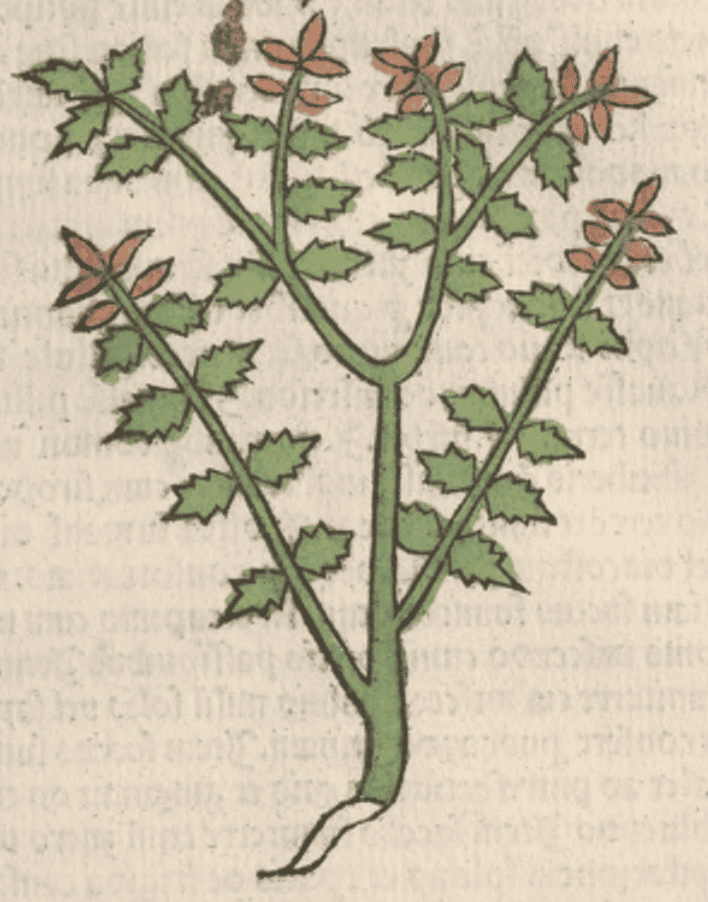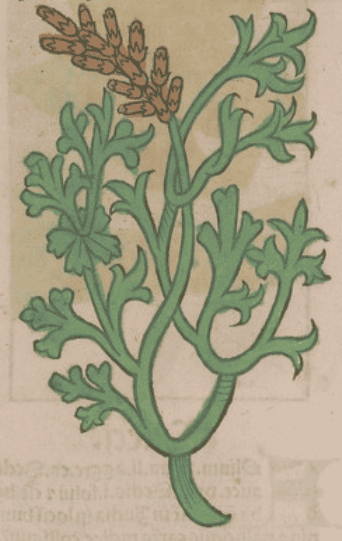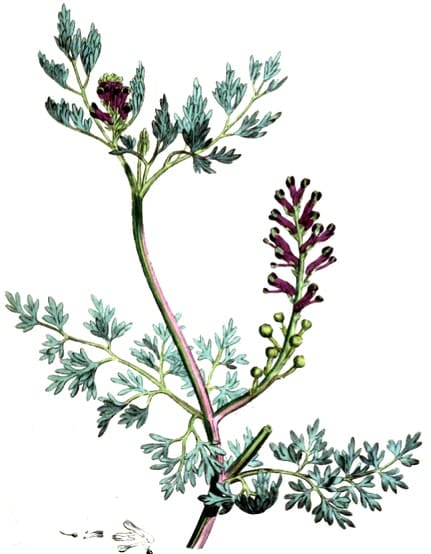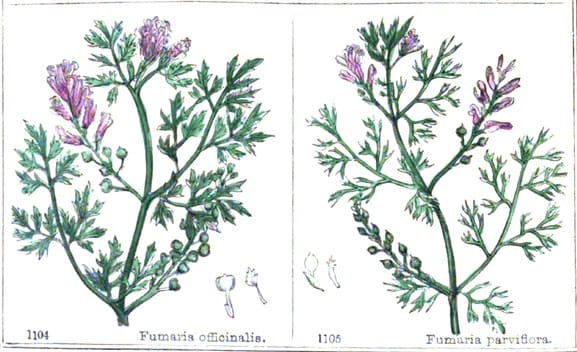Fumaria, FumitoryTraditionally called Fuma Terra (‘Earth Smoke’)Parpata (Ayurveda) Shahtara (Unani) |

|

|
 Herbarius latinus, Petri, 1485
Herbarius latinus, Petri, 1485 |
 Ortus Sanitatis, Meydenbach, 1491
Ortus Sanitatis, Meydenbach, 1491 |
 Medicinal Plants, Millspaugh, 1892
Medicinal Plants, Millspaugh, 1892 F. officinalis (left), F. parviflora (right)
F. officinalis (left), F. parviflora (right)Florigraphia Britannica, Deakin, 1857
Botanical name:
Fumaria spp.
- F. officinalis (official western)
- F. indica, F. parviflora, F. vaillantii (used in Ayurveda)
- Common or Purple Fumitory (F. officinalis)
- Fine-leaved or Lesser Fumitory
- White Broad-leaved or Climbing Fumitory
- Yellow or Mountain Fumitory
Parts used:
Herb in flower; rarely the Seed
‘The seeds of Fumitory are stronger’ (Avicenna)
Temperature & Taste:
Cool, dry. Bitter
“Cold in the First and Dry in Second degree”. (Avicenna)
Classifications:
2A APERIENT. 2F. PURIFYING
3B. FEBRIFUGE & ANTIPYRETIC. 3E. DIURETIC
4e. STOMACHIC. 4f. SPLENETIC. 4g. HEPATIC
TCM:
B. Clears Heat and Damp
Uses:
1. Clears Liver Heat, Opens Obstructions:
-good for the Liver and Spleen; opens Obstructions, Jaundice
-purges Choler (Bile); Liver heat disorders
-diseases of the Spleen and Abdomen from Heat, Bile or Melancholy
2. Clears Melancholy and Heat from the Blood
-purges burnt Humors, cleanses the Blood
–“taken orally in case of Itching and Scabies” (Avicenna)
-chronic skin diseases, Acne, Spots, Scabs, Eczema, Psoriasis
-Leprosy, Syphilis, Scrofula, Fibroid tumors, Cancers.
–‘eminently good against Hypochondriac Melancholy’ (Salmon)
3. Clears Heat and Damp, Promotes Urine:
-Edema; Gravel, Stones, Gout, Rheumatism
4. Benefits Stomach, Promotes Digestion:
–‘strengthens the stomach’ (Avicenna)
-opens the Bowels, and strengthens them
5. Promotes Menstruation:
-obstructed and painful menstruation
-claimed by some to benefit Fertility
6. Externally:
-chronic and obstinate skin diseases including Eczema, Psoriasis, Acne, Pimples, Leprosy, either topically as a plaster or paste, or more commonly as a wash or bath.
-wash for Spots and Pimples.
-Boiled in water or whey, or the distilled water used as a wash, it was long used as a cosmetic to improve skin complexion and make it fair.
-wash for Venereal Sores, Pustules and Ulcers including those coming from Venereal Disease.
-wash for mouth and throat sores.
-eyewash for Conjunctivitis, Spots of the Eyes and similar Eye conditions.
-topically for Lice (juice mixed with vinegar or the acid tincture as a wash
-‘Fumitory strengthens the gum’ (Avicenna)
Dose:
1. The Seed has the vertues of the Herb, but is regarded as stronger
2. Avicenna gave particularly large doses of Fumitory. Taken in larger doses will act as a purgative.
3. Avicenna also said it is taken with Sugar.
In Decoction: 6–15 grams; Avicenna said 30–200 grams (probably referring to the fresh plant)
Powder of the Herb: 2–4 grams; Avicenna said 10–23 grams
Powder of the Seed: 1–2 grams (up to 3 or 4 grams)
Juice: 2–3 spoonfuls in wine
Tincture: up to 2 or 3 drams
Correctives:
Chicory
Substitutes:
1. Chebulic Myrobalan. (Unani)
2. Senna in half its quantity, especially for Scabies and Chronic Fever.. (Avicenna)
3. Celandine
Main Combinations:
Borage & Fumitory
Hops & Fumitory
1.. Chronic Skin diseases, Psoriasis, Leprosy, Fibroid Tumors:
i. Fumitory Water and Syrup of Endive (Herbarium Horstianum, 1630)
ii. Fumitory with Aloe, Chebulic, Yellow and Black Myrobalans as in Pills of Fumitory of Avicenna)
iii. Fumitory with Bugloss, Hops, Endive, Chicory, Raisin, Licorice (as in Decoction of Fumitory of Andernacus)
iv. Fumitory with Yellow Myrobalan, Violet, Dodder, Wormwood (as in Syrup of Fumitory Lesser of Mesue)
v. Fumitory with Endive, Wormwood, Hops, Dodder (as in Syrup of Fumitory)
vi. Fumitory with Dodder, Oregano, Pennyroyal, Polypody, Black Myrobalan, Yellow Myrobalan, Rhubarb (as in Electuary of Dodder and Fumitory of Mesue)
2. Pruritus:
i. Fumitory water, Strawberry water, Veronica water (Herbarium Horstianum, 1630)
ii. Fumitory with Yellow Myrobalan, Senna, Wormwood (as in Electuary for Scabies and Pruritis of Rhasis)
iii. Fumitory juice, Oil of Walnuts (3 oz. each), with wax form an ointment. (The Secrets of Alexis, 1615)
3. Eczema, Fumitory with Burdock and Cleavers
4. Cleanse Heat and Melancholy from the Blood:
i. Fumitory, Senna
ii. Syrup of Fumitory with Water of Scabious or Endive (Herbarium Horstianum, 1630)
iii. Fumitory with Thyme, Chicory, Agrimony, Wormwood, Polypody, Senna, Licorice (as in Decoction of Fumitory)
5. Scrofula:
i. Fumitory with Figwort
ii. Fumitory with Cleavers, Burdock, Bittersweet (as in Infusion for Scrofula)
6. Clear Heat from the Stomach, Fumitory with Wormwood and Chebulic Myrobalan (Wirtzung)
7. Liver Heat:
i. Fumitory Water and Syrup of Endive (Herbarium Horstianum, 1630)
ii. Fumitory with Chicory and Agrimony (Herbarium Horstianum, 1630)
8. Liver heat and obstruction:
i. Fumitory, Endive, Chicory root (Herbarium Horstianum, 1630)
ii. Fumitory with Chicory, Agrimony, Horehound, Wormwood, Aniseed, Fennel seed, Ginger, Raisin, Senna (as in Opening Hepatic Decoction)
9. Hepatitis A, Fumitory, Tephrosia, Swertia, Sphaeranthus, Red Sandalwood, Madder (Unani)
10. Gall Stones, Fumitory with Celandine, Wormwood, Balm, Peppermint.
11. Cachexia and Liver weakness, take Diarrhodon Abbatis with Fumitory water. (Herbarium Horstianum, 1630)
12. Liver weakness, Conserve of Fumitory with Conserve of Rose (Herbarium Horstianum, 1630)
13. Fever:
i. Fumitory has been combined with Chicory or Dandelion
ii. Fumitory, Tinospra, Emblic Myrobalan, White Sandalwood (Ayurveda)
14. Leukoderma, Fumitory with Alum, Saltpeter, Red Earth, mixed with Vinegar and applied. (Ayurveda)
15. Strangury, decoction of Fumitory in Wine.
Major Formula
Potion for Ascites
Potion for Unulcerated Cancer
Decoction of Fumitory of Mesue
Decoction of Fumitory of Andernacus
Decoction of Fumitory Compound
Syrup of Fumitory
Syrup of Fumitory Lesser (Mesue)
Syrup of Fumitory Greater (Mesue)
Syrup of Fumitory Compound (Augustana)
Confection of Rhubarb (Mesue)
Electuary of Dodder and Fumitory (Mesue)
Electuary for Scabies and Pruritis (Rhasis)
Pills of Fumitory (Avicenna)
Pills of Fumitory and Senna (Unani)
Cautions:
1. Not used during pregnancy.
Toxicity
Studies in rodents have shown no toxic effects with long term administration. (See here)
Main Preparations used:
Water of the Herb, Spirit, Distilled Oil, Dehydrated Juice, Conserve of the Tops, Syrup of the Juice, Extract, Salt of the Ashes
1. Conserve of Fumitory:
i. Fresh leaves of Fumitory (stalks removed) 1 part; bruise until a homogenous mass is formed, then with White Sugar 2 parts, mix to form a conserve. Some used 3 parts of Sugar.
2. Fumitory Juice:
i. Bruise the fresh herb in a stone mortar, express strongly, and clarify by briefly boilings; strain again and preserve it. (Pharmacopoeia Hispana, 1798)
ii. some just kept the freshly expressed juice under a layer of oil which will preserve it for some time.
3. Extract of Fumitory:
i. Bruise and express the juice, evaporate it until one fourth of the powdered herb is required to give it the consistency of an extract.
ii. Fumitory (1 pound), Spring Water (10 pounds). Macerate 2 days, strain, set aside, then decant the clear liquor. Then evaporate to the consistency of an extract.
iii. Bruise the fresh herb in a mortar and express the juice. Add to it half its weight of dried herb and macerate several hours; then heat to almost boiling, strain with slight expression and clarify with the white of an egg. Then evaporate to the required consistency. (Pharmacopee Usuelle, Louvain, 1821)
4. Syrup of Fumitory Juice.
i. Juice of Fumitory, clarified by boiling and straining, White Sugar (of each 3 pounds); boil slowly to the thickness of Honey.
ii. Depurated Fumitory Juice (1 part), Sugar (2 parts). Dissolve in a water-bath. (Pharmacopoeia Gallica, 1818)
5. Distilled Water of Fumitory:
i. Fumitory, bruised (1 part), Water (2 parts). Distil to two-thirds. (Pharmacopoeia Sardoa, 1773)
ii. Some distilled the juice to near dryness to obtain the Distilled Water.
6. Spirit of Fumitory:
i. Fumitory (6 parts), Proof Spirit (4 parts), Water (1 part). Distil one pound and a half, and re-distil from fresh herb. (Dispensatorium medico pharmaceuticum Palatinatus, 1764)
|
‘The Pitpapra sold in Bombay does not appear to be the Fumaria parviflora, as it has a smooth fruit without a double pit at the apex; it is imported from Persia, and is doubtless F. officinalis. Several species of Fumitory have long been used medicinally, and were highly esteemed by the Greeks and Romans on account of their diuretic and alterative properties. Dioscorides calls the plant Kapnos, and Pliny derives the name Fumaria from Fumus, smoke, with the explanation that the plant irritates the eyes like smoke; it has also been called Fumus terra with reference to the colour of the foliage, or its smell. Fumitory does not appear to have been mentioned by the early Sanskrit writers. The Arabians and Persians probably derived their knowledge of it from the Greeks, as they hold the same high estimate of its properties. In the Makhzan-el-Adwiya two varieties are mentioned, one with violet-coloured flowers, and |
a large kind with white flowers; it is described as diuretic and alterative, removing hepatic obstructions, aperient and expellant of the humors, but more especially of Atrabilis; two Greek names are given, Kiasusi and Kafnus ; the Arabic names are Baklat-el-Malik, and Shahteraj, a corruption from the Persian. In India the drug is still highly esteemed by the Mahometans. For a European account of the properties and uses of Fumitory, Handschuch “De plantia Fumariaceis,” &c, may be consulted. Fumitory is laxative and diuretic; it is beneficial in dyspepsia depending upon torpidity of the liver and in scrofulous skin affections. Dose— 2 ounces of the decoction (1 ounce to 1 pint) three times a day.’ (Vegetable Materia Medica of Western India, Dymock, 1885) |
